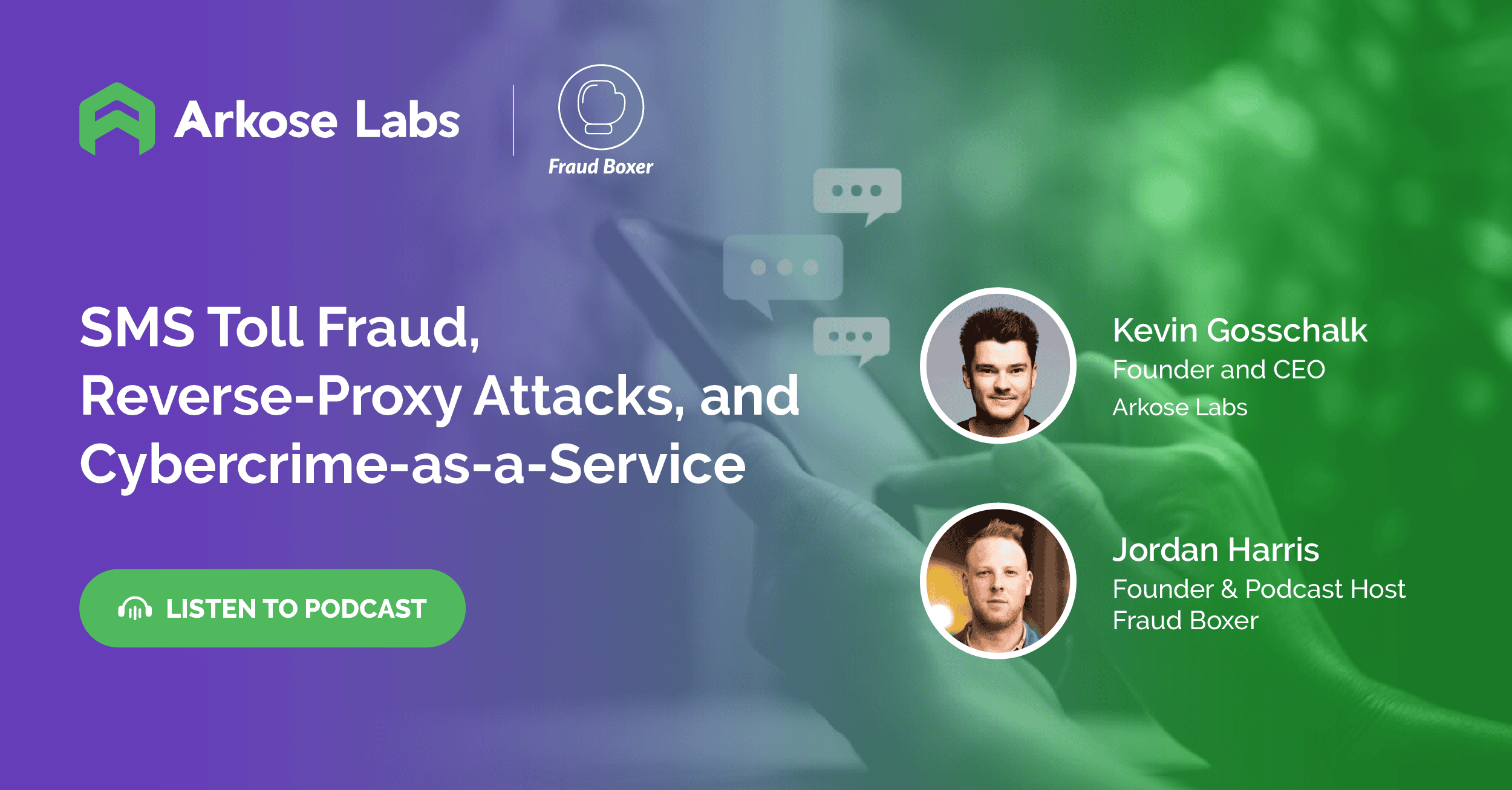We’ve got just the thing for you! Check out this recent podcast between Kevin Gosschalk, Founder and CEO of Arkose Labs, and Fraud Boxer’s Jordan Harris as they discuss the current and evolving challenges in the cybersecurity space, including:
- the evolution of bad bots
- updates on SMS toll fraud
- how Man-in-the-Middle (MITM) Reverse Proxy attacks are enabling threat actors to bypass multi-factor authentication (without social engineering)
- plenty of strategies to detect and mitigate these ongoing threats
With the world constantly evolving and technology advancing, cybercrime has become increasingly sophisticated. Regrettably, this implies that businesses need to be extra alert and informed about the latest cybercrime tactics to safeguard their customers' data and their own operations. This also means it is crucial for businesses to have a comprehensive understanding of the various methods of cybercrime, so they can take the necessary measures to protect themselves from these threats.
Listen to the podcast:

RECOMMENDED RESOURCE
SMS Toll Fraud, Reverse-Proxy Attacks, and Cybercrime-as-a-Service with Fraud Boxer’s Jordan Harris
Intelligent Bots
Intelligent bots are automated computer programs designed to perform malicious actions on the internet. These bad bots can be used for a variety of purposes, including web scraping, spamming, phishing, and distributed denial of service (DDoS) attacks. Bad bots can wreak havoc on websites, stealing sensitive information, damaging reputations, and even bringing down entire systems. They can also be used to manipulate online advertising or to artificially inflate website traffic. As the use of bad bots continues to grow, businesses and organizations need to take proactive measures to protect themselves from these dangerous and costly threats.
As discussed in the podcast, the long-term strategy for beating bad bots with Arkose Labs is a lot different than that of other vendors. When fraudsters using automated bots to launch attacks do not make money on the threat, then it’s not worth it for them to continue. In this sense, the best way to mitigate bot threats is to render the attack unprofitable by throwing up challenges that cannot be met. This frustrates threat actors and sends them packing long before any sort of payload is realized.
Businesses using a standard bot solution, which is designed to stop bad bot activity, only about 90% of the attacks are mitigated. The only reason the other 10% is penetrating defenses is because the percent that gets past is enough to fund the attacks. Whether or not the bots are successful, the solution only stops the attack once.
SMS Toll Fraud
SMS toll fraud is a type of cybercrime that involves sending fraudulent text messages to victims in order to gain access to personal information or financial accounts. This method of attack has become increasingly popular because it is difficult to detect and can be used to target individuals as well as businesses. The attacker will typically send a text message that appears to be from a trusted source, such as a bank or other financial institution, and then ask for confidential information. Once the attacker has the information, they can use it to gain access to accounts or steal money.
SMS toll fraud can be particularly hard to spot, as messages usually appear to be from a reliable sender and often contain accurate contact information. Furthermore, attackers may employ social engineering tactics to entice victims to provide confidential data or click on malicious links. Once the attacker has the information, they can gain access to financial accounts and make money transfers, as well as use the data to access other personal details, such as passwords, Social Security numbers, and credit card numbers.
Reverse-Proxy Attacks
Reverse-proxy attacks are another type of cybercrime that can be difficult to detect. This method of attack involves using a malicious server to hide the attacker’s IP address and location. The attacker will use the malicious server to redirect traffic from a legitimate website or server to the attacker’s own malicious website. This type of attack is particularly dangerous because it can be used to gain access to sensitive information or to launch other types of cyberattacks.
A reverse-proxy attack may also be used to launch a DDoS attack. In this type of attack, multiple malicious servers will be used to flood the target with an overwhelming amount of traffic, making it difficult or impossible for legitimate users to access the website. A DDoS attack can be used to take down an entire network or a website and can be difficult to defend against. In addition, reverse-proxy attacks can also be used to redirect users to websites containing malicious code, which can be used to infect computers with malware or viruses.
Cybercrime-as-a-Service
Finally, CaaS is a type of cybercrime that has become increasingly popular. This type of attack involves a criminal offering their services to other criminals. These services can include setting up malicious servers, carrying out reverse-proxy attacks, or helping to carry out SMS toll fraud. Cybercrime-as-a-service can be used to target individuals or businesses, and is often used to launch bigger attacks.
The services that are offered through CaaS are often used to attack companies for financial gain. This can be done by stealing sensitive data, such as customer credit card information, or by using ransomware to demand payment from the victim. It can also be used to carry out distributed denial of service (DDoS) attacks, which can shut down an entire network. Criminals may also use the services to spread malware, which can be used to spy on users or to steal information. The scope of the attack can vary, but the ultimate goal is to disrupt operations and gain access to valuable data.
Summary
During the podcast featuring Jordan Harris, the founder of Fraud Boxer, a range of cybercrimes were discussed, highlighting the significance of staying up-to-date with the latest threats. For businesses to safeguard themselves against these threats, it is crucial that they remain attentive and well-informed about the various forms of cybercrime. Through comprehensive knowledge of the different types of cybercrime, businesses can take the appropriate measures to shield both their customers' data and their own operations. Listen now.
To find more about how Arkose Labs can protect your business from growing cybercrime, contact us today or book a demo.


